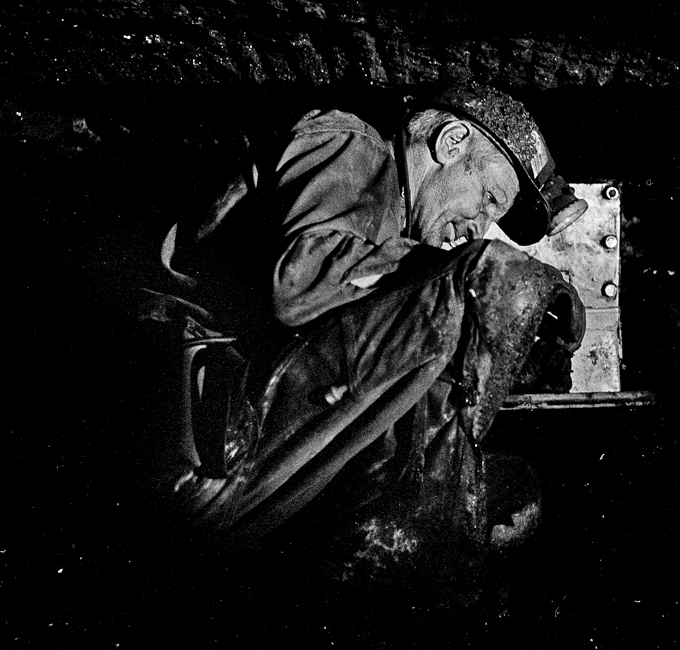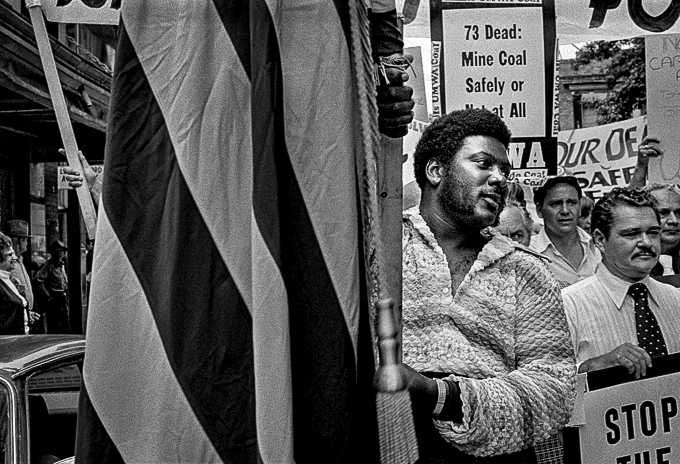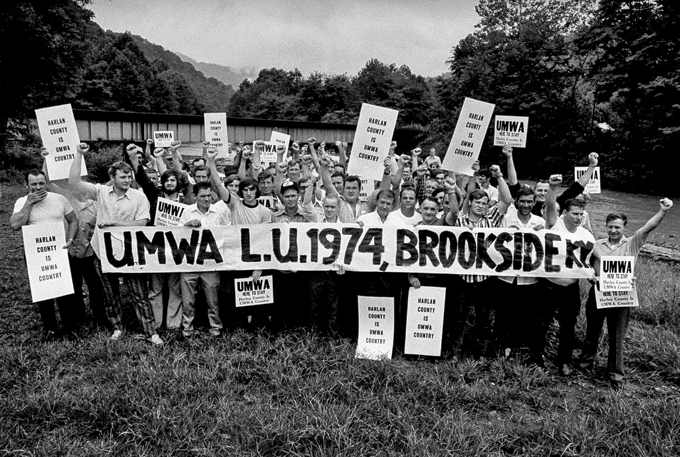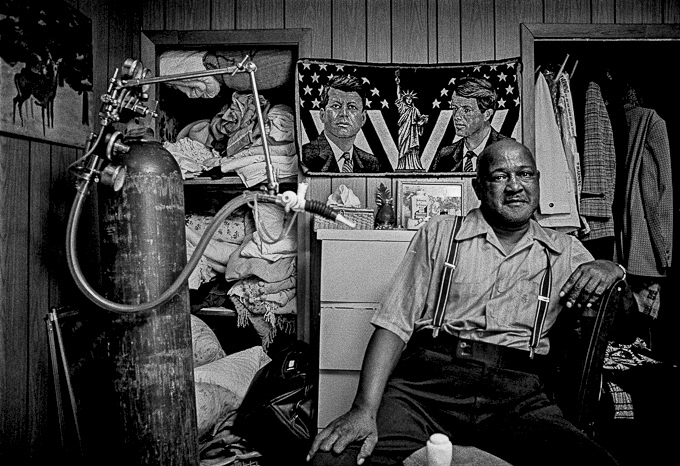Miners for Democracy – 50 years on it’s back to the future
By Steve Early

On December 14, 1972, coal miners rocked the American labor movement by electing three reformers as top officers of the United Mine Workers of America (UMWA), a union which at the time boasted 200,000 members and a culture of workplace militancy without peer.
In national balloting supervised by the U.S. Department of Labor (DOL), Arnold Miller, Mike Trbovich and Harry Patrick ousted an old guard slate headed by W.A. (“Tony”) Boyle, the benighted successor to John L. Lewis, who ran the UMWA in autocratic fashion for 40 years. Boyle’s opponents, who campaigned under the banner of Miners for Democracy (MFD), had never served on the national union staff, executive board, or any major bargaining committee. Instead, 50 years ago they were propelled into office by wildcat strike activity and grassroots organizing around job safety and health issues, including demands for better compensation for black lung disease, which afflicted many underground miners.

Today, at a time when labor militants are again embracing a “rank-and-file strategy” to revitalize unions and change their leadership, the MFD’s unprecedented victory — and its turbulent aftermath — remains relevant and instructive. In the United Auto Workers (UAW), for example, local union activists recently elected to national office — and fellow reformers still contesting for headquarters positions in a runoff that begins January 12 — will face similar challenges overhauling an institution weakened by corruption, cronyism and labor-management cooperation schemes. Some UAW members may doubt the need for maintaining the opposition caucus, Unite All Workers for Democracy (UAWD), that helped reformers get elected, but the MFD experience shows that such political breakthroughs are just the first step in changing a dysfunctional national union.
Imagine what it was like for coal miners in the 1970s to challenge an even more corrupt and deeply entrenched union bureaucracy, with a history of violence and intimidation directed at dissidents. When Joseph (“Jock”) Yablonski, a Boyle critic on the UMWA executive board, tried to mount a reform campaign for the UMWA presidency in 1969, that election was marked by systematic fraud later investigated by the DOL. Soon after losing, Yablonski was fatally shot by union gunmen, along with his wife and daughter, as Mark Bradley recounts in Blood Runs Coal: The Yablonski Murders and the Battle for the United Mine Workers of America.
Just three years later, MFD candidates were able to oust Boyle and his closest allies, but without winning control of the national union executive board. As inspiring as it was at the time, this election victory ended up demonstrating the limitations of reform campaigns for union office when they’re not accompanied by even more difficult efforts to build and sustain rank-and-file organization. Of all the opposition movements influenced by the MFD, in the 1970s and afterwards, only Teamsters for a Democratic Union (TDU) has achieved continuing success as a reform caucus, largely due to its singular focus on membership education, leadership development and collective action around workplace issues.
Contested elections are rare
Then and now, contested elections in which local union leaders — not to mention working members — challenge national union officials are very rare. Rising through the ranks in organized labor generally means waiting your turn, and when you capture a leadership position, holding on to it for as long as you can. Aspiring labor leaders most easily make the transition from local elected positions to appointed national union staff jobs if they conform politically.
Dissidents tend to be passed over for such positions or not even considered unless union patronage is being deployed by those at the top to co-opt actual or potential critics. As appointed staffers move up via the approved route, whether in the field or at union headquarters, they gain broader organizational experience by “working within the system” rather than bucking it.
If they become candidates for higher elective office later in their careers, they enjoy all the advantages of de facto incumbency (by virtue of their full-time positions, greater access to multiple locals and politically helpful headquarters patrons). Only a few national unions — including the UMWA, Teamsters, the NewsGuild/CWA, and now, with inspiring results so far, the UAW—permit all members to vote directly on top officers and executive board members.
Different route to the top
On paper, coal miners long had a “one-member, one-vote” system. But, by the late 1960s, there had not been a real contest for the UMWA presidency in four decades. Lacking the stature of his legendary predecessor John L. Lewis, a founder of the Congress of Industrial Organizations, Tony Boyle had become a compliant tool of the coal industry, unwilling to fight for better contracts or safer working conditions. Increasingly restive miners staged two huge wildcat work-stoppages protesting national agreements negotiated in secret by Boyle (with no membership ratification). In 1969, 45,000 UMWA members joined an unauthorized strike demanding passage of stronger federal mine safety legislation and a black lung benefits program for disabled miners in West Virginia.
Despite passage of the 1959 Landrum-Griffin Act, which created a “bill of rights” for union members, Boyle was able to maintain internal control by putting disloyal local unions and entire UMWA districts under trusteeship, which deprived members of the right to vote on their leaders. Jock Yablonski’s martyrdom set the stage for a rematch with Boyle. It took the form of a government-run election, ordered after a multi-year DOL investigation of violence, intimidation, vote-tampering and misuse of union funds by Boyle’s political machine. The standard bearers for reform in 1972 were Yablonski supporters who created MFD as a formal opposition caucus a few months after his death. They also published a rank-and-file newspaper called The Miners Voice as an alternative to the Boyle-controlled UMW Journal.
At MFD’s first and only convention, 400 miners adopted a 34-point union reform platform and nominated Arnold Miller from Cabin Creek, W.V. as their presidential candidate. Miller was a disabled miner, leader of the Black Lung Association and former soldier whose face was permanently scarred by D-Day invasion injuries. His running mates included another military veteran, 41-year-old Harry Patrick, a voice for younger miners, and Mike Trbovich, who helped coordinate Yablonski’s campaign in Pennsylvania. Despite continuing threats, intimidation, and heavy red-baiting throughout the coalfields, the MFD slate ousted Boyle by a margin of 14,000 votes out of 126,700 cast in December 1972.
Propelled by militancy
The union establishment was deeply shocked and unsettled by this electoral upset. Not a single major labor organization (with the exception of the independent United Electrical Workers) applauded the defeat of Boyle, an already convicted embezzler, who was later indicted and found guilty of ordering the assassination of Yablonski. The MFD victory and its tumultuous 10-year aftermath has been chronicled by such authors as former UMWA lawyer Tom Geoghegan in Which Side Are You On? Trying to Be for Labor When It’s Flat on Its Back, labor studies professor Paul Clark in The Miners Fight for Democracy: Arnold Miller and the Reform of the United Mine Workers, women’s studies professor Barbara Ellen Smith in Digging Our Own Graves: Coal Miners and the Struggle of Black Lung Disease, and the late Paul Nyden, a Charleston Gazette reporter, in Rebel Rank and File: Labor Militancy and Revolt from Below During the Long 1970s, a collection of case studies about the period’s labor insurgency.
As Nyden noted, the MFD’s grassroots campaign “channeled the spontaneous militancy arising throughout the Appalachian coal fields.” Before and after their election, MFD candidates had key allies inside and outside the union. Among the former, according to Nyden, were “wives and widows of disabled miners, wildcat strikers, and above all the young miners who were dramatically reshaping the composition of the UMWA.” Among the “outsiders” were community organizers, coalfield researchers, former campus activists, investigative journalists, and public interest lawyers, some of whom would later play influential roles as new national union staffers.
The MFD inherited a deeply divided organization, with internal and external problems that would have been daunting for any new leaders, not just working members suddenly catapulted from the coalfields into unfamiliar union headquarters jobs. In Digging Our Own Graves, Smith faults MFD leaders for deciding to “dismantle their own insurgent organization” because the “skeletal network of rank-and-file leaders” that was the MFD had “basically become the institutional union.”
“Many activists joined the union’s staff or became preoccupied with running for office in their new autonomous districts,” she writes. “The decision to disband the MFD had serious consequences, however. It left the new administration without a coherent rank-and-file base and it left the rank-and-file without an organized vehicle to hold their new leaders accountable.”
Photo of Harlan

The reformers elected in 1972 did succeed in democratizing the structure and functioning of the UMWA. They also revitalized union departments dealing with workplace safety, organizing, membership education, internal communication, and strike support (see Harlan County USA, an Academy Award-winning documentary, about one early test of the MFD’s commitment to fighting back, rather than selling out).
In the crucial area of national contract negotiations and enforcement, greatly heightened membership expectations were harder to meet. A 1974 settlement with the Bituminous Coal Operators Association (BCOA) provided wage increases of 37% over three years, a first-ever cost-of-living allowance, improvements in pensions and sick pay, strengthened safety rights and job security protection. But the new leadership’s approach to grievance procedure reform did not resolve the greatest point of tension between rank-and-file militants and those among them elevated to top union office.
In the mid-1970s, the underground miner tradition of direct action was still so strong that UMWA members regularly walked off the job over local disputes of all kinds. Their culture of solidarity enabled roving pickets to shut-down mines nearby, in the next county, or an adjoining state, even if a different BCOA employer was targeted and the conflicts involved were unrelated.
These wildcat strikes subjected the national union to potentially ruinous damage suits by coal operators seeking to enforce a much ignored “no strike” clause, which required most grievances to be submitted to binding third-party arbitration. In 1974, new UMWA negotiators did not press for an open-ended grievance procedure that might have turned such quick strikes into a more disciplined and legal tool for contract enforcement. Instead, they agreed to the creation of an Arbitration Review Board, which merely added another frustrating step to a dispute resolution process already back-logged and overly judicialized. As post-contract discontent mounted in 1975 and 1976, an estimated 80,000 to 100,000 miners joined unauthorized strikes for the “right to strike,” while also protesting federal court sanctions (fines or imprisonment) of strikers who ignored back-to-work orders.
A counter revolution
Within the union, the conservative Boyle forces continued to be a strong obstructionist force in some UMWA districts. Frustrated by Arnold Miller’s shortcomings as a negotiator and administrator, the most promising MFD leader — Secretary-Treasurer Harry Patrick — mounted an unsuccessful challenge to his fellow officer in a three-way race for the UMWA presidency in 1977.
Re-elected with a former Boyle supporter as his running-mate, Miller became increasingly weak, isolated and ineffective. His erratic handling of national bargaining with the BCOA helped set the stage for a 111-day strike by 160,000 miners who had to battle both the coal operators and their own faltering leadership. Highlights of that 1977-78 struggle included two contract rejections and a failed Taft-Hartley Act back-to-work order sought by President Jimmy Carter, a White House intervention even more controversial than Joe Biden’s role in the current national rail labor dispute.
UMWA contract concessions in 1978 and 1981 made organizing the unorganized increasingly difficult. More coal production shifted to the West, where huge surface mines required much smaller workforces, which usually remained “union free.” In the meantime, the multi-employer BCOA began to fragment, leaving the UMWA with fewer and fewer companies with which to negotiate an overarching national contract. Even firms operating in the eastern coalfields started non-union affiliates or subsidiaries, in what was becoming a declining industry.
More competent, progressive leadership was not restored until a second-generation reformer, Richard Trumka, took over as UMWA president in 1982. Trumka defeated Sam Church, who replaced Miller when the latter retired, after multiple heart attacks, in 1979. Trumka had gained valuable experience in the UMWA legal department during the mid-1970s. He had been a working miner before going to law school and then returned to the mines in preparation for seeking union office. But even with steadier, more skilled hands at the helm — and an inspiring strike victory at the Pittston Coal Company in 1989 — the union entered a downward spiral of reduced membership and diminished organizational clout.
Long before Trumka’s ascendency, most of the college-educated non-miners, who were swept into key positions by the MFD’s victory in 1972, had left UMWA employment. Some went to work for other unions, including the Teamsters under the TDU-backed presidency of Ron Carey in the 1990s. In 1995, Trumka become secretary-treasurer of the national AFL-CIO and, 14 years later, its president until his death last year at age 72. At the UMWA, he handed the reigns to his vice-president Cecil Roberts, who was part of the generation of recently-returned Vietnam veterans who got jobs in the mines and backed the MFD in 1972. Roberts serves on the AFL-CIO executive council and continues to rally UMWA members and their families against a resurgence of black lung disease due to coal and silica dust exposure among underground miners.
But, in recent years, the UMWA has been much preoccupied with the bankruptcy of leading coal producers, resulting lay-offs, and related political fights to protect the pensions and healthcare coverage of retirees who now far outnumber working members. Since April 2021, more than 1,000 Alabama members have been on strike against Warrior Met Coal, which is currently the union’s most high-profile contract struggle. Four years ago, Roberts — now 76 years old — was re-elected by acclamation to his sixth full term as national president. This makes him the second longest serving UMWA leader after John L. Lewis.
As modern UMWA history confirms, the road to rank-and-file power includes many pot holes and more than a few detours along the way. If union members can create a durable opposition movement and effectively utilize direct election of top officers, even many decades of institutional stagnation can be replaced by uplifting periods of organizational revitalization. But struggles for union democracy and reform often face larger constraints, including downsizing and restructuring of the industry which employs those seeking to revitalize their union and improve its leadership. Auto workers in the UAW have long suffered from a less severe decline of their basic industry but now have a rare and exciting opportunity to turn a union reform victory into a longer-lasting embrace of new organizing, bargaining and strike strategies that would benefit both white-collar and blue-collar members.
…
This article is also running in “In These Times”
